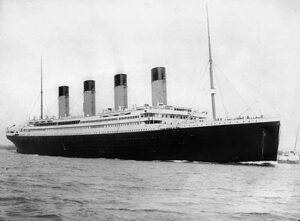
The missing “Missing Titanic submarine” – In an extraordinary turn of events resembling a Hollywood thriller, a submersible watercraft carrying high-paying tourists on a mission to explore the wreckage of the RMS Titanic has gone missing. As the search intensifies to locate the submersible before the passengers’ oxygen supply runs out, both the Canadian Armed Forces and the US Coast Guard have joined the efforts off the coast of Cape Cod. Although the identities of the individuals on board have not been officially confirmed, it is known that the passengers include Hamish Harding, a British businessman residing in the United Arab Emirates, as well as Shahzada Dawood, a Pakistani businessman, and his son, Sulaiman Dawood.
While this captivating story has captured national attention, it is interesting to reflect on the contrasting response given to the recent tragic incident involving a boat filled with desperate migrants in the Mediterranean. With dozens killed and hundreds still missing, the plight of these migrants, predominantly from Syria, Egypt, and Pakistan, seeking a better life and the failures that led to their situation deserve widespread outrage and sorrow. Yet, it seems the frenzy surrounding the small group of affluent tourists lost at sea garners more breathless coverage and constant updates, despite the disparity in human suffering.
Human interest and the allocation of attention are often disproportionate to the scale of human suffering and unrelated to who or what deserves significant recognition. The tale of a vessel occupied by wealthy curiosity-seekers vanishing in the ocean depths while in search of a vessel occupied by wealthy curiosity-seekers lost decades ago possesses all the elements that make for an addictive narrative: irony, suspense, potential tragedy, potential glory, glimpses into the lifestyles of the rich, aspirations, and hubris.
The rescue effort itself provides a spectacle that captivates, with a ticking countdown until oxygen depletion heightening the stakes to the utmost degree. Furthermore, the novelty factor cannot be overlooked. Who among us, the average citizens, even knew that embarking on a private “submersible” journey to witness the Titanic wreckage was an option? This story allows us a glimpse into lives and adventures that most of us can only imagine, evoking a mix of aspiration and resentment.
The parallels drawn to the Titanic, a story that continues to fascinate over a century after its tragic demise, add another layer of intrigue. The sinking of the Titanic resonates partly due to its profound hubris—the grand “unsinkable” ship carrying affluent passengers and laden with luxury meeting a dramatic and cinematic end. The catastrophe unfolded swiftly, too fast for timely assistance, but slow enough to be documented in subsequent on-screen replays. The ship was ultimately swallowed by the ocean and remained hidden for decades. The moral lesson remains: no human creation can contend with the forces of Mother Nature. Now, a small group of ostentatiously wealthy individuals, paying exorbitant sums that surpass the annual earnings of many Americans, have vanished into the depths of a profound abyss.
Fear and curiosity constitute additional elements at play in this narrative. There exists an inherent fear of the unknown and that which lies beyond the familiar lands we inhabit—fear of the deep waters in our oceans, fear of the vastness of space. Simultaneously, curiosity propels us to explore further, pushing the boundaries of our understanding. However, countless explorers throughout history have paid the ultimate price—their lives—validating the fear while reminding us of the consequences that accompany curiosity.
Ideally, as a species, our attention would be directed towards events based on their actual significance and scale. Yet, we find ourselves captivated by grand and unanswerable questions: What lies beyond? How far can humanity venture? What are the consequences of pushing the limits too far? A select few individuals, fueled by curiosity and talent, dedicate their lives to answering these questions. Meanwhile
, a handful of the extremely wealthy allocate their resources to experience extraordinary places, whether in the depths of the ocean or the expanse of space.
The rest of us observe and await the outcome of this story, hoping for a moral lesson to emerge that we can contemplate and learn from. However, this is not a parable—it involves five human beings and numerous others working tirelessly to save their lives. Our sincerest hope is for their successful rescue, followed by a sense of responsibility from the affluent passengers to reimburse the cost of the extensive and likely publicly funded search effort. Subsequently, we should collectively redirect our attention to narratives that offer invaluable lessons—stories of individuals who courageously embark on perilous journeys in pursuit of a better life. Although these stories may lack cinematic appeal, they possess far greater importance.




